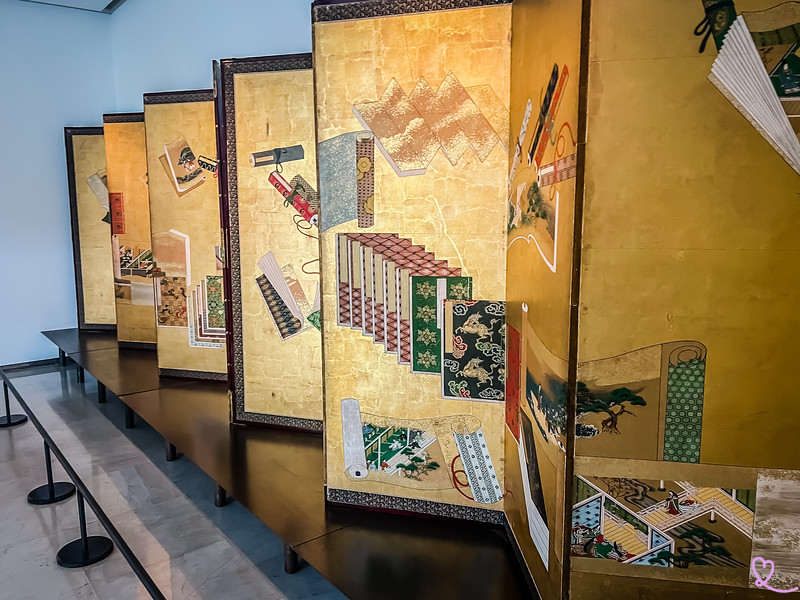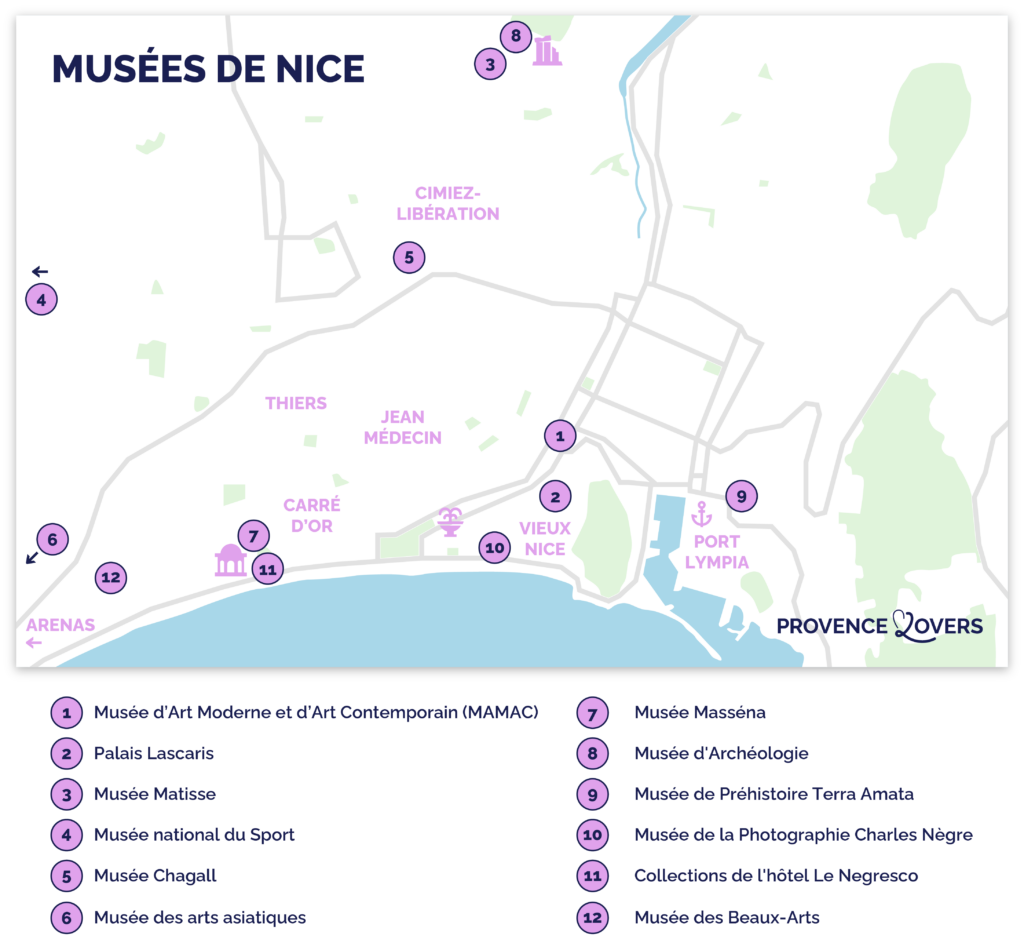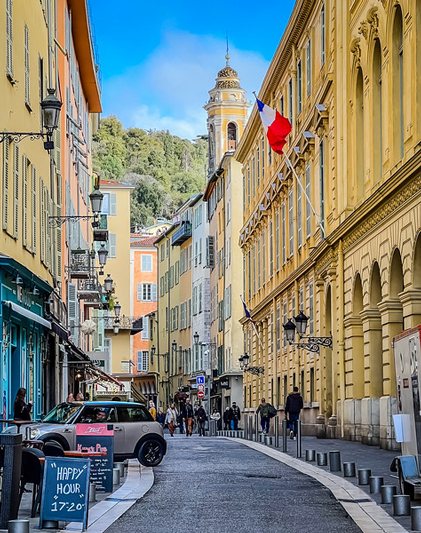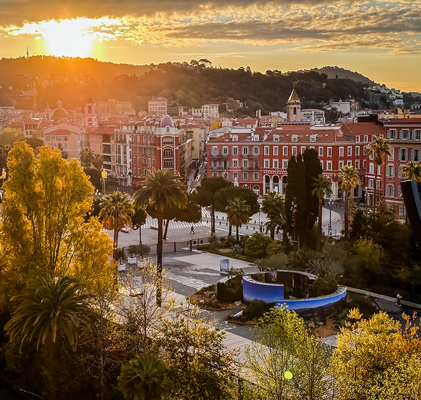A real curiosity in Nice’s Arenas district, visit the Asian Arts Museum of Nice and discover this place of art in the Côte d’Azur capital.
Here are our tips for planning your visit to the Museum of Asian Art in Nice on the Côte d’Azur.

This guide is completely independent, based on our experiences. We visited the region anonymously, making our own choices and paying our bills in full.
Is a visit to Nice’s Museum of Asian Arts worthwhile?
Yes, Nice’s Museum of Asian Arts is well worth a visit. We really appreciated the museography, which showcases the works in sober, uncluttered rooms. The surprising architecture of the site is also worth a visit!
It’s one of Nice’s most beautiful museums, which we listed in our article dedicated to the city’s best activities.

What you can see
Surprising architecture

The building housing Nice’s Museum of Asian Arts is a work of art in itself. Designed by the Japanese architect Kenzo Tange in raw concrete surrounded by water, whose style is influenced by the Swiss urban architect Le Corbusier, it is quite original in relation to the architectural style of the area. The museum’s architecture plays on the contrast between massive forms and transparent walls. The white marble on the walls lends a sense of solidity, while the glass surfaces lend lightness and transparency.
A museum on water

The Asian Arts Museum is set above the park’s lake, in the middle of a lush green setting that stands out from Nice’s Arénas district (the city’s international business center). We had an almost magical feeling of floating on water.
Permanent collections on the first floor

We also really appreciated the museography, which showcases the works in sober, uncluttered rooms. Sculptures, paintings, chests, headdresses, traditional costumes, masks… We found these collections quite simply magnificent. On the first floor, the museum displays a permanent collection with a varied range of works.
The elegance of ceremonial armor

Among the pieces on display in the permanent collection, we had the pleasure of discovering the elegance and finesse of ceremonial armors like the one shown here. This marvel dates back to the 1st half of the 19th century in Japan. It bears the emblem of the Hetto clan, which ruled the Sakura estate in the late Edo period (Tokyo’s former name) under Emperor Meiji. At the back, admire this gold-leaf Japanese screen, testimony to the exceptional craftsmanship of the Land of the Rising Sun.
The majestic central staircase

In the center of the building, you can observe and climb the spiral staircase, reminiscent of the helix of the DNA molecule. It provides access to the basement, where rarely exhibited objects are displayed, as well as to the first floor. It can also be interpreted as a representation of the backbone of the architectural ensemble.
Statues and sculptures upstairs

If you go upstairs in the museum, several Asian statues and sculptures are displayed in a circle in the dynamic whirlpool or helix of the central spiral staircase. At the time of our visit, this statuary production illustrated Buddhist worship in several Asian countries, including Thailand, Cambodia, Nepal and Burma.
Rare items in the basement

In the basement spaces, this art venue has decided to launch a new museographic adventure by exhibiting rare objects representative of Asian art. This multi-volume exhibition aims to lift the veil on the works of art held in the departmental museum’s storerooms. A space that aroused our curiosity and will surely arouse yours!
Design in the Far East: between tradition and modernity

Still in the basement, behind the central staircase, we discovered design objects combining tradition and contemporary style. Both functional and aesthetic, they reveal a genuine quest for harmony in the environment of intellectuals and artists in China and neighboring countries. Surrounding oneself with objects conducive to meditation, harmony and the pleasure of contemplation is at the heart of craft tradition and artistic creation in the Far East.
Photography in the spotlight in the museum lobby

Leaving the museum’s main hall, a corridor led us to the gift store before the exit. We had the pleasure of admiring a temporary exhibition of large-format black and white prints. That day, the theme of the exhibition, created by photojournalist Alain Schroeder, was the child jockeys of Sumbawa, Indonesia, in the form of a short photographic series.
The souvenir store, a little cave of wonders

Before leaving the museum, your visit ends with a visit to the souvenir store. It was a veritable wonderland for us! Collector’s books on Asian history and art, cast-iron teapots in a variety of colors, decorative tableware, stone statuettes… A place that’s sure to give you ideas for original gifts or souvenirs!
Musée des arts asiatiques in Nice: how to get there
Where is the museum?
- In Nice
- From Nice-City station = 11min by car and 35min by tramway
- to the west of the city, in the Arénas district, a 10-minute drive from the Sports Museum (Nice’s Allianz Stadium), Botanical Gardens and International Museum of Naive Art

Access by car and parking
Access by car to the Arénas district is recommended as it is more convenient. If arriving from the A8 freeway, take the “Promenade des Anglais” exit opposite the airport, then turn left into the driveway towards “Arénas”.
To reach the museum by car from Nice Centre, take the Promenade des Anglais towards Cannes, then, opposite the airport, turn into the side alley at Parc Phoenix (pay parking).

The museum does not have a dedicated parking lot, but you can park your vehicle in the paid parking lots:
- the Indigo Arénas parking lot, a 2-minute walk from the museum entrance
- the Arénas-Cassin parking lot, a 2-minute walk from the museum entrance
OUR TPS FOR RENTING YOUR CAR IN Provence
- Compare prices on our preferred platform: DiscoverCars – one of the best rated sites.
- Choose a car that is powerful enough (the roads are steep) but compact (some passages are narrow).
- Think of thecomplete insurance (some roads are tortuous and narrow).
- There is a lot of demand, book it early.

Public transport access
The museum is accessible by public transport:
- Tramway line 2, “Parc Phoenix” stop
- Bus line 12, “Aéroport/Promenade” stop
- Vélo bleu station no. 10 (self-service bike rental in Nice, see details here)

Visiting difficulties
The museum presents no particular difficulties and is accessible to people with reduced mobility.
Lockers are available on request from reception.
Avoid bringing suitcases or large bags on your visit, as you will be refused entry.
DISCOVER Nice
- Best things to do in Nice
- Where to stay in Nice: 15 best hotels
- Where to eat in Nice: 20 best restaurants
- The 12 best museums in Nice
- Best beaches
- Visit the Palais Lascaris
- Visit the MAMAC Museum
- Visit the Museum of Photography
- Itineraries: 1 day – 2 days – 3 days – 5 days – 7 days
- Rent a car in Nice (airport or train station)
- Most beautiful villages around Nice

Tips for visiting the Asian Art Museum
Schedules and prices
The museum is open:
- Wednesday to Monday, 10 a.m. to 5 p.m. September 1 to June 30
- Wednesday to Monday, 10 a.m. to 6 p.m. July 1 to August 31
- Closed on Tuesdays, January 1st, May 1st and December 25th
Rates:
- Free admission for self-guided tours
- Full price guided tour: €5
- Reduced-rate guided tour: €2.50
The museum also organizes special workshops and tea ceremonies from time to time.
See the latest news on the official website here.
How long
Allow 1 to 2 hours to visit the museum’s 3 interior spaces and its grounds.

Best moment
To avoid the crowds at weekends, we recommend that you plan your visit for the weekday morning opening. It’s one of Nice’s must-visit sites, and while there are likely to be tourists during the summer months, the Côte d’Azur is a popular destination all year round. So there will always be visitors.
Direction of visit
There’s no set way to visit the building, but we recommend you start upstairs and work your way down to the basement. Finish off with the permanent collections on the first floor, before moving on to the temporary photographic exhibition hall and gift store.

Visiting with children
Children will love the museum, which offers a range of family activities such as guided tours, introductory courses in comic strips and Chinese calligraphy. Find out more on the museum’s official website here.
Eating out
We didn’t see any on-site dining facilities. However, the museum is within easy reach of the city center by car or public transport. Discover our selection of the best restaurants in Nice.
Hotels
You’re right in the center of Nice. Here are our recommendations:
WHERE TO STAY IN Nice
Our favorites: neighborhoods and hotels
On the waterfront, with sea view:
Anantara Hotel – See prices, photos and availability
In the new town, close to the sea:
Hotel Apollinaire, elegant and bright – See prices, photos and availability
In the old town, with all the charm:
AparthotelAMMI Vieux Nice very practical and pleasant – see prices, photos and availability

PLAN YOUR TRIP TO provence
Our articles are coming!
- Most beautiful cities in Provence (coming soon)
- Most beautiful beaches of Provence (coming soon)
- Most beautiful villages of Provence (to come)
- Most beautiful destinations in Provence (coming soon)


